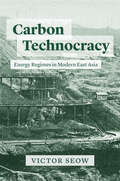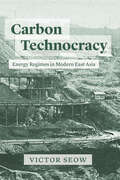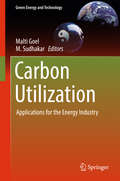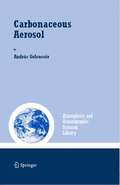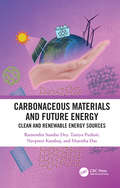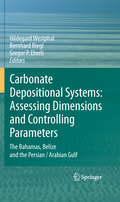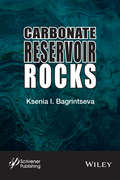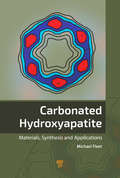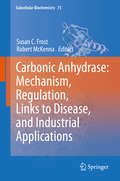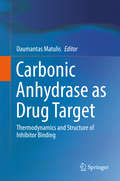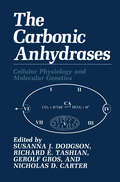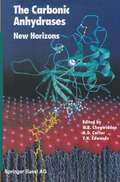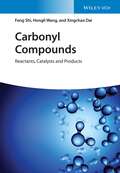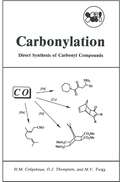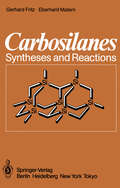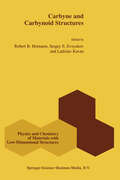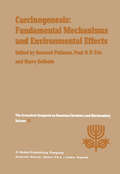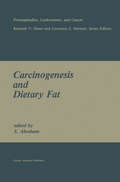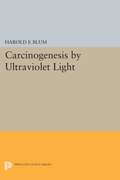- Table View
- List View
Carbon Technocracy: Energy Regimes in Modern East Asia (Studies of the Weatherhead East Asian Institute)
by Victor SeowA forceful reckoning with the relationship between energy and power through the history of what was once East Asia’s largest coal mine. The coal-mining town of Fushun in China’s Northeast is home to a monstrous open pit. First excavated in the early twentieth century, this pit grew like a widening maw over the ensuing decades, as various Chinese and Japanese states endeavored to unearth Fushun’s purportedly “inexhaustible” carbon resources. Today, the depleted mine that remains is a wondrous and terrifying monument to fantasies of a fossil-fueled future and the technologies mobilized in attempts to turn those developmentalist dreams into reality. In Carbon Technocracy, Victor Seow uses the remarkable story of the Fushun colliery to chart how the fossil fuel economy emerged in tandem with the rise of the modern technocratic state. Taking coal as an essential feedstock of national wealth and power, Chinese and Japanese bureaucrats, engineers, and industrialists deployed new technologies like open-pit mining and hydraulic stowage in pursuit of intensive energy extraction. But as much as these mine operators idealized the might of fossil fuel–driven machines, their extractive efforts nevertheless relied heavily on the human labor that those devices were expected to displace. Under the carbon energy regime, countless workers here and elsewhere would be subjected to invasive techniques of labor control, ever-escalating output targets, and the dangers of an increasingly exploited earth. Although Fushun is no longer the coal capital it once was, the pattern of aggressive fossil-fueled development that led to its ascent endures. As we confront a planetary crisis precipitated by our extravagant consumption of carbon, it holds urgent lessons. This is a groundbreaking exploration of how the mutual production of energy and power came to define industrial modernity and the wider world that carbon made.
Carbon Technocracy: Energy Regimes in Modern East Asia (Studies of the Weatherhead East Asian Institute)
by Victor SeowA forceful reckoning with the relationship between energy and power through the history of what was once East Asia’s largest coal mine. The coal-mining town of Fushun in China’s Northeast is home to a monstrous open pit. First excavated in the early twentieth century, this pit grew like a widening maw over the ensuing decades, as various Chinese and Japanese states endeavored to unearth Fushun’s purportedly “inexhaustible” carbon resources. Today, the depleted mine that remains is a wondrous and terrifying monument to fantasies of a fossil-fueled future and the technologies mobilized in attempts to turn those developmentalist dreams into reality. In Carbon Technocracy, Victor Seow uses the remarkable story of the Fushun colliery to chart how the fossil fuel economy emerged in tandem with the rise of the modern technocratic state. Taking coal as an essential feedstock of national wealth and power, Chinese and Japanese bureaucrats, engineers, and industrialists deployed new technologies like open-pit mining and hydraulic stowage in pursuit of intensive energy extraction. But as much as these mine operators idealized the might of fossil fuel–driven machines, their extractive efforts nevertheless relied heavily on the human labor that those devices were expected to displace. Under the carbon energy regime, countless workers here and elsewhere would be subjected to invasive techniques of labor control, ever-escalating output targets, and the dangers of an increasingly exploited earth. Although Fushun is no longer the coal capital it once was, the pattern of aggressive fossil-fueled development that led to its ascent endures. As we confront a planetary crisis precipitated by our extravagant consumption of carbon, it holds urgent lessons. This is a groundbreaking exploration of how the mutual production of energy and power came to define industrial modernity and the wider world that carbon made.
Carbon Trading in China: Environmental Discourse and Politics
by Alex LoThis book explores the political aspects of China's climate change policy, focusing on the newly established carbon markets and carbon trading schemes. Lo makes a case for understanding the policy change in terms of discourse and in relation to narratives of national power and development.
Carbon Utilization: Applications for the Energy Industry (Green Energy and Technology)
by Malti Goel M. SudhakarThis book provides in-depth information on topics relating to anthropogenic carbon dioxide utilization processes. Presenting a collection of state-of-the-art scientific reviews and research perspectives on carbon management strategies of relevance to the energy industry, it features contributions by leading scientists and technocrats across 19 chapters as an Indian contribution In the energy industry, new processes for carbon dioxide removal and recycling are developing quickly, and it is in this context that the book provides an opportunity to review the current status of and promote efforts to achieve effective carbon capture and management. The contents presented here will prove useful to researchers, students, industry experts, scientists and policymakers alike.
Carbonaceous Aerosol (Atmospheric and Oceanographic Sciences Library #30)
by András GelencsérThe concept of carbonaceous aerosol has only recently emerged from atmospheric pollution studies; even standard nomenclature and terminology are still unsettled. This monograph is the first to offer comprehensive coverage of the nature and atmospheric role of carbonaceous aerosol particles. Atmospheric chemists, physicists, meteorologists, and modellers will find this a thought-inspiring and sometimes provocative overview of all global phenomena affected by or related to carbonaceous aerosol.
Carbonaceous Materials and Future Energy: Clean and Renewable Energy Sources
by Ramendra Sundar Dey Taniya Purkait Navpreet Kamboj Manisha DasModern lifestyle demands consistent supply of energy for our daily need and comfort. To encounter global demands for energy and to permit for diminution of fossil fuels, there is an urgent need for efficient, sustainable and clean energy sources. Carbonaceous material such as graphene, carbon nanotubes, fullerenes, mesoporous carbon, carbon nanofibres and their composites are extensively studied material. They are playing important role to alternative clean energy sources. This book reviews the roadmap of various form of carbonaceous materials used in several energy devices and provides guideline of future perspective.
Carbonaceous Materials and Future Energy: Clean and Renewable Energy Sources
by Ramendra Sundar Dey Taniya Purkait Navpreet Kamboj Manisha DasModern lifestyle demands consistent supply of energy for our daily need and comfort. To encounter global demands for energy and to permit for diminution of fossil fuels, there is an urgent need for efficient, sustainable and clean energy sources. Carbonaceous material such as graphene, carbon nanotubes, fullerenes, mesoporous carbon, carbon nanofibres and their composites are extensively studied material. They are playing important role to alternative clean energy sources. This book reviews the roadmap of various form of carbonaceous materials used in several energy devices and provides guideline of future perspective.
Carbonate Depositional Systems: The Bahamas, Belize and the Persian/Arabian Gulf
by Hildegard Westphal Bernhard Riegl Gregor P. P. EberliCarbonate sediments are of increasing relevance for archives of past environmental conditions and for economical reasons in areas of geothermal energy and hydrocarbon reservoirs. Complex interaction of physical and chemical parameters with biological parameters determines the architecture and composition of carbonate sedimentary bodies. This book closes some of the still existing gaps in our understanding of the influence and interplay of physical, chemical, and biological parameters with carbonate sedimentation. An understanding of this interaction is not only required for reliable prediction of reservoir quality but also for a robust interpretation of environmental conditions in the past and the present. It is written by geologists for geologists in order to provide an easily accessible overview of the large amount of relevant information provided by the neighbouring sciences. The approach of the book is to document the modern depositional environments of three classical areas of carbonate deposition, each characteristic for a specific sedimentological setting (isolated platform, attached shelf, ramp) in order to assess both the range of physical, biological and chemical parameters and their sedimentary response. This book presents a comprehensive compilation based on data from published work and unpublished theses, and the integration of these data in order to extract previously undiscovered relationships between the discussed parameters and carbonate deposition.
Carbonate Reservoir Rocks
by Ksenia I. BagrintsevaMost of the world’s energy still comes from fossil fuels, and there are still many strides being made in the efficiency and cost effectiveness of extracting these important and increasingly more elusive natural resources. This is only possible if the nature of the emergence, evolution, and parameter estimation of high grade reservoir rocks at great depths is known and a theory of their forecast is developed. Over 60 percent of world oil production is currently associated with carbonate reservoir rocks. The exploration, appraisal and development of these fields are significantly complicated by a number of factors. These factors include the structural complexity of the carbonate complexes, variability of the reservoir rock types and properties within a particular deposit, many unknowns in the evaluation of fracturing and its spatial variability, and the preservation of the reservoir rock qualities with depth. The main objective of most studies is discovering patterns in the reservoir rock property changes of carbonate deposits of different genesis, composition and age. A short list of the unsolved issues includes: the role of facies environment in the carbonate formation; the major geologic factors affecting the formation of high-capacity reservoir rocks and preservation of their properties; recommendations as to the use of the new techniques in studies of the structural parameters; and establishing a correlation between the major evaluation parameters. The focus of this volume is to show the scientific and engineering community a revolutionary process. The author perfected an earlier developed methodology in studies of the void space structure (Bagrintseva’s method, 1982). This methodology is based on carbonate rock saturation with luminophore and on special techniques in processing of photographs made under UV light. The luminophore technique was combined with the raster electron microscopy and its variation, the studies under the cathode luminescence regime. This combination enabled a more detailed study of the reservoir void space, the nonuniformity in the open fracture evolution, their morphology, length and variability of openness. Over recent years these techniques have found wide application. Useful for the veteran engineer or scientist and the student alike, this book is a must-have for any geologist, engineer, or student working in the field of upstream petroleum engineering.
Carbonate Reservoir Rocks
by Ksenia I. BagrintsevaMost of the world’s energy still comes from fossil fuels, and there are still many strides being made in the efficiency and cost effectiveness of extracting these important and increasingly more elusive natural resources. This is only possible if the nature of the emergence, evolution, and parameter estimation of high grade reservoir rocks at great depths is known and a theory of their forecast is developed. Over 60 percent of world oil production is currently associated with carbonate reservoir rocks. The exploration, appraisal and development of these fields are significantly complicated by a number of factors. These factors include the structural complexity of the carbonate complexes, variability of the reservoir rock types and properties within a particular deposit, many unknowns in the evaluation of fracturing and its spatial variability, and the preservation of the reservoir rock qualities with depth. The main objective of most studies is discovering patterns in the reservoir rock property changes of carbonate deposits of different genesis, composition and age. A short list of the unsolved issues includes: the role of facies environment in the carbonate formation; the major geologic factors affecting the formation of high-capacity reservoir rocks and preservation of their properties; recommendations as to the use of the new techniques in studies of the structural parameters; and establishing a correlation between the major evaluation parameters. The focus of this volume is to show the scientific and engineering community a revolutionary process. The author perfected an earlier developed methodology in studies of the void space structure (Bagrintseva’s method, 1982). This methodology is based on carbonate rock saturation with luminophore and on special techniques in processing of photographs made under UV light. The luminophore technique was combined with the raster electron microscopy and its variation, the studies under the cathode luminescence regime. This combination enabled a more detailed study of the reservoir void space, the nonuniformity in the open fracture evolution, their morphology, length and variability of openness. Over recent years these techniques have found wide application. Useful for the veteran engineer or scientist and the student alike, this book is a must-have for any geologist, engineer, or student working in the field of upstream petroleum engineering.
Carbonated Hydroxyapatite: Materials, Synthesis, and Applications
by Michael E. FleetThis book introduces recent advances in understanding the crystal structure of carbonate hydroxylapatite (also known as bone mineral), which forms the hard tissue of bones and teeth. Bone mineral is the reservoir for carbon dioxide in the body and maintains the concentration of mineral ions in body fluids at homeostasis. The detailed structure of b
Carbonic Anhydrase: Mechanism, Regulation, Links To Disease, And Industrial Applications (Subcellular Biochemistry #75)
by Susan C. Frost Robert McKennaThe study of carbonic anhydrase has spanned multiple generations of scientists. Carbonic anhydrase was first discovered in 1932 by Meldrum and Roughton. Inhibition by sulfanilamide was shown in 1940 by Mann and Keilin. Even Hans Krebs contributed to early studies with a paper in 1948 showing the relationship of 25 different sulfonamides to CA inhibition. It was he who pointed out the importance of both the charged and uncharged character of these compounds for physiological experiments. The field of study that focuses on carbonic anhydrase (CA) has exploded in recent years with the identification of new families and isoforms. The CAs are metalloenzymes which are comprised of 5 structurally different families: the alpha, beta, gamma, and delta, and epsilon classes. The alpha class is found primarily in animals with several isoforms associated with human disease. The beta CAs are expressed primarily in plants and are the most divergent. The gamma CAs are the most ancient. These are structurally related to the beta CAs, but have a mechanism more similar to the alpha CAs. The delta CAs are found in marine algae and diflagellates. The epsilon class is found in prokaryotes in which it is part of the carboxysome shell perhaps supplying RuBisCO with CO2 for carbon fixation. With the excitement surrounding the discovery of disease-related CAs, scientists have redoubled their efforts to better understand structure-function relationships, to design high affinity, isotype-specific inhibitors, and to delineate signaling systems that play regulatory roles over expression and activity. We have designed the book to cover basic information of mechanism, structure, and function of the CA families. The authors included in this book bring to light the newest data with regard to the role of CA in physiology and pathology, across phylums, and in unique environmental niches.
Carbonic Anhydrase as Drug Target: Thermodynamics and Structure of Inhibitor Binding
by Daumantas MatulisThis book offers deep insights into the thermodynamics and molecular structures of the twelve catalytically active isoforms of human carbonic anhydrase (CA) with a particular focus on inhibitor binding for drug design. X-ray crystallographic structures in combination with enzyme kinetic testing provide information on the interaction of CAs and their inhibitors, knowledge which is crucial for rational drug design. CAs are zinc carrying enzymes that catalyse the reversible interconversion of carbon dioxide and bicarbonate and are involved in numerous cellular processes. They are therefore a common target for drugs. The suppression of CA activities through inhibitory compounds has found application for example in diuretics and in glaucoma therapy. In this book methods used to determine binding thermodynamics of inhibitory compounds (Isothermal titration calorimetry, Fluorescent thermal shift assay/differential scanning fluorimetry and others) will be compared in detail. Also types and chemical synthesis of CA inhibitors, the use of antibodies against CAs as well as inhibitor application in animals are discussed.
The Carbonic Anhydrases: Cellular Physiology and Molecular Genetics
by N. D. Carter S. J. Dodgson G. Gros R. E. TashianAs we approach the twenty-first century the problems of industrialization are evident: we find there is a greenhouse effect, the ozone layer is being depleted, the rain is acidified, and there is a terrible problem of increasing C0 concentrations in the atmo 2 sphere. The carbonic anhydrases are a unique family of enzymes that solve these problems in the human body: they are responsible for converting C0 (a gas) to 2 HC0-, which is the biggest intracellular buffer, with a concomitant decrease in a 3 hydroxyl ion. Globally, the functions of the carbonic anhydrases in photosynthesis in rain forests and in the algae and plankton that cover our oceans indicate that they are also of utmost importance in the maintenance of the acid-base balance on our planet. Although the whole field of C0 metabolism is enormous and still rapidly 2 expanding, because of the research interests of the editors this book is mainly concerned with mammalian carbonic anhydrases. However, if the interested reader intends to purify carbonic anhydrases from nonmammalian sources, Dr. Cheg widden has provided the necessary information in Chapter 7. The carbonic anhydrases were first discovered in 1933; until1976 there were thought to be only two isozymes. Since then CA ill, IY, V, VI, and Vll have been discovered and well characterized. There is, of course, no reason to believe that we have found them all.
The Carbonic Anhydrases: New Horizons (Experientia Supplementum #90)
by W. R. Chegwidden N. D. Carter Y. H. EdwardsCarbonic anhydrase (CA) is a seemingly ubiquitous enzyme of profound physiological importance, which plays essential roles in respiration, acid-base homeostasis, bone resorption, calcification, photosynthesis, several biosynthetic pathways and a variety of processes involving ion, gas and fluid transfer. This enzyme, which is present in at least three gene families (a, ß, ?), has found favour as a model for the study of evolution of gene families and for site-directed mutagenesis in structure/function relationships, for protein folding and for transgenic and gene target studies. Since the early use of CA inhibitors as diuretics and in treating congestive heart failure, the enzyme has been target of considerable clinical attention. Much of this is now focused on endeavours to produce a new generation of such drugs for the effective treatment of glaucoma and other potential applications. Recent data, suggesting links between CA and various disease processes, including cancer, have stimulated further...
The Carbonic Anhydrases: Current and Emerging Therapeutic Targets (Progress in Drug Research #75)
by W. Richard Chegwidden Nicholas D. CarterThis volume assembles and integrates the wealth of diverse information that is now accumulating in this burgeoning field. The existing and potential therapeutic applications of targeting CA cover a remarkably wide-range of diseases and disorders and have generated increasing and extensive interest in recent years. Its inter-disciplinary approach embraces both the most up-to-date therapeutic application of CA-targeting and the latest research data that will provide a platform for the development of novel applications. The interested audience comprises scientists and clinicians from many relevant disciplines within science and medicine.
Carbonyl Compounds: Reactants, Catalysts and Products
by Feng Shi Hongli Wang Xingchao DaiCarbonyl Compounds Discover how carbonyl compounds bridge reactants, catalysts, and specific products Carbonyl-containing molecules represent some of the most versatile functionalities in organic chemistry, with applications in a wide variety of areas. In Carbonyl Compounds: Reactants, Catalysts and Products, accomplished chemists and authors Feng Shi, Hongli Wang, and Xingchao Dai deliver a comprehensive treatment of these multi-functional compounds. You’ll discover how to build carbonyl molecules with traditional and non-traditional methods, how to transform carbonyl-containing molecules into fine chemicals, and how to use carbonyl-containing molecules as catalytic materials for the synthesis of fine chemicals. The book is a comprehensive and systematic treatment of carbonyl compounds as reactants, catalysts, and products. From the use of carbon monoxide in the hydroformylation of alkenes and alkynes to the reactions via carbonyl and hydroxyl groups recycling, you’ll find everything you need to know about these versatile compounds. Readers will also benefit from the inclusion of: A thorough introduction to carbonyl molecules as reactants, including treatments of carbon monoxide, carbon dioxide, HCHO, HCOOH, and CO surrogates An exploration of carbonyl compounds as catalysts, including acid catalyzed reactions with -CO2H and reactions via carbonyl and hydroxyl groups recycling A practical discussion of the synthetic applications of carbonyl compounds, including the synthesis of functional molecules and the synthesis of functional materials A concise treatment of future perspectives and potential research trends for carbonyl molecules Perfect for organic, catalytic, pharmaceutical, and physical chemists, Carbonyl Compounds will also earn a place in the libraries of chemical engineers and materials scientists seeking a one-stop reference for up-to-date information about the building, transformation, and applications of carbonyl-containing molecules.
Carbonyl Compounds: Reactants, Catalysts and Products
by Feng Shi Hongli Wang Xingchao DaiCarbonyl Compounds Discover how carbonyl compounds bridge reactants, catalysts, and specific products Carbonyl-containing molecules represent some of the most versatile functionalities in organic chemistry, with applications in a wide variety of areas. In Carbonyl Compounds: Reactants, Catalysts and Products, accomplished chemists and authors Feng Shi, Hongli Wang, and Xingchao Dai deliver a comprehensive treatment of these multi-functional compounds. You’ll discover how to build carbonyl molecules with traditional and non-traditional methods, how to transform carbonyl-containing molecules into fine chemicals, and how to use carbonyl-containing molecules as catalytic materials for the synthesis of fine chemicals. The book is a comprehensive and systematic treatment of carbonyl compounds as reactants, catalysts, and products. From the use of carbon monoxide in the hydroformylation of alkenes and alkynes to the reactions via carbonyl and hydroxyl groups recycling, you’ll find everything you need to know about these versatile compounds. Readers will also benefit from the inclusion of: A thorough introduction to carbonyl molecules as reactants, including treatments of carbon monoxide, carbon dioxide, HCHO, HCOOH, and CO surrogates An exploration of carbonyl compounds as catalysts, including acid catalyzed reactions with -CO2H and reactions via carbonyl and hydroxyl groups recycling A practical discussion of the synthetic applications of carbonyl compounds, including the synthesis of functional molecules and the synthesis of functional materials A concise treatment of future perspectives and potential research trends for carbonyl molecules Perfect for organic, catalytic, pharmaceutical, and physical chemists, Carbonyl Compounds will also earn a place in the libraries of chemical engineers and materials scientists seeking a one-stop reference for up-to-date information about the building, transformation, and applications of carbonyl-containing molecules.
Carbonylation: Direct Synthesis of Carbonyl Compounds
by H.M. Colquhoun D.J. Thompson M.V. TwiggSince the publication of our earlier book on transition metal mediated organic synthesis, * there has been a widespread increase of interest in this topic, and transition metal based methodology has become firmly established in many areas of organic chemistry. The direct, catalytic formation of organic carbonyl compounds using carbon monoxide as the source of the carbonyl group has seen exceptional progress, and this carbonylation chemistry is being used increasingly in research and on a larger scale for fine chemicals production. In view of these developments, there is a need for a modem, practi cally oriented book dealing with transition metal based carbonylation chemistry. The present monograph should help fulfill this need, since it is intended specifically to foster the adoption of catalytic carbonylation as a general tool in synthetic organic chemistry. It deals exclusively with reactions involving the interconversion of carbon monoxide and organic carbonyl compounds, and although the majority of the reactions discussed involve catalytic formation of carbonyl compounds, potentially valuable syntheses requiring stoichiometric quantities of transition metal are also included. In addition, a chapter is devoted to the remarkably useful reverse transformation (decarbonylation), in which an organic carbonyl group is eliminated in the form of carbon monoxide.
Carbosilanes: Syntheses and Reactions
by Gerhard Fritz Eberhard MaternCarbosilanes are compounds in which the elements silicon and carbon alternate in the molecular skeleton [1]. Just as the alkanes are formally derived from the diamond lattice and the aromatics from the graphite lattice, the carbosilanes are structurally derived from silicon carbide. Because of the tetravalent nature of silicon and carbon we can expect stable linear, cyclic and polycyclic compounds to occur. However, carbosilanes do not exist in nature. This book is an attempt to give a summarized presentation. Carbosilanes are, of course, part" of organosilicon chemistry, but their behavior differentiates them distinctly from other organosilicon compounds. The differences result primarily from the alternating Si-C-Si arrangements in the molecular skeleton, and especially the various methylene bridges (CH , CHX, CX ; X = halogen) cause changes in z z Si-C bond polarization and hence influence the reaction possibilities. It is convenient to regard carbosilanes as similar to silicones except that the oxygen bridges of silicones are replaced by methylene units. However, this does not accurately account for all the chemical properties of these compounds. Carbosilanes are related more directly to silicon carbide, as shown occasionally by the reactive behavior of polycyclic car bosilanes. Therefore, in view of the present interest shown for thermally stable cera mics of unusual character, interesting possibilities arise for further development. Most cyclic carbosilanes can be classified in two groups: the carborundanes and the Si-scaphanes. Compounds belonging to the carborundane class maintain Si-C six-membered rings in the boat conformation.
Carbyne and Carbynoid Structures (Physics and Chemistry of Materials with Low-Dimensional Structures #21)
by R. B. Heimann S. E. Evsyukov Ladislav KavanThis is a book on one of the most fascinating and controversial areas in contemporary science of carbon, chemistry, and materials science. It concisely summarizes the state of the art in topical and critical reviews written by professionals in this and related fields.
Carcinogenesis: Proceedings of the Thirteenth Jerusalem Symposium on Quantum Chemistry and Biochemistry Held in Jerusalem, Israel, April 28 – May 2, 1980 (Jerusalem Symposia #13)
by A. Pullman Paul O. P. Ts'O H. GelboinProceedings of the 13th Jerusalem Symposium on Quantum Chemistry and Biochemistry held in Jerusalem, Israel, April 28-May 2, 1980
Carcinogenesis by Ultraviolet Light (PDF)
by Harold Francis BlumThis book represents the culmination of over fifteen years of experimental and theoretical studies aimed at the elucidation of the process by which ultraviolet light induces cancer. In so far as possible the subject matter is treated from a quantitative point of view, whether dealing with the effects of ultraviolet light on isolated cells or on more integrated systems including the induction of cancer. A description of the course of carcinogenesis by ultraviolet light is presented, based on experimental data, in which cancer is treated as a growing tissue mass. This constitutes probably the most complete summary of a cancer process formulated up to this time.Originally published in 1959.The Princeton Legacy Library uses the latest print-on-demand technology to again make available previously out-of-print books from the distinguished backlist of Princeton University Press. These editions preserve the original texts of these important books while presenting them in durable paperback and hardcover editions. The goal of the Princeton Legacy Library is to vastly increase access to the rich scholarly heritage found in the thousands of books published by Princeton University Press since its founding in 1905.
